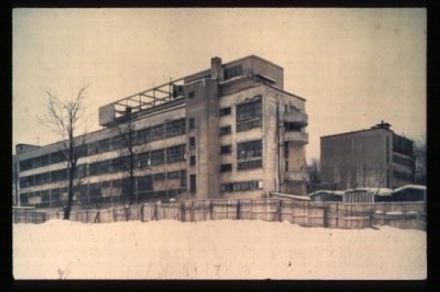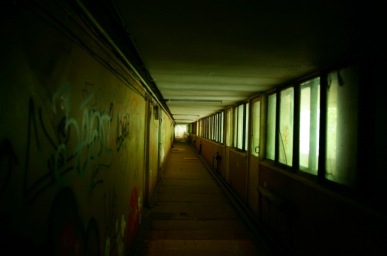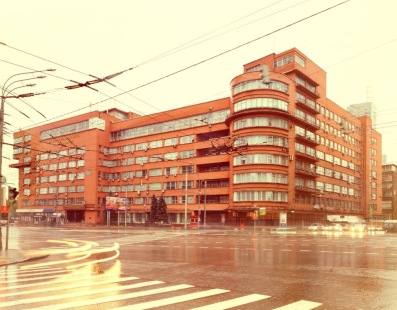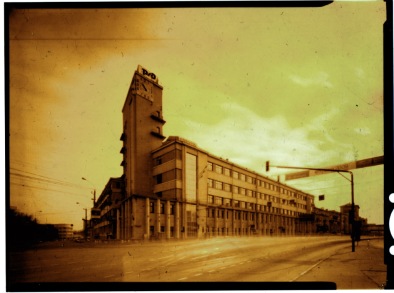Including Gastev’s landmark book
How to work/Как надо работать
 .
.
Image: From the USSR to America,
the chronometric revolution (1925)
 .
.

Futuristic drawing of Aleksei Gastev by Tolkachev (1924)
Download ÐлекÑей ГаÑтев - Как надо работать (1923) [Aleksei Gastev – How to Work]
The following are excerpts from my thesis on the scientific management of labor and psychotechnics in the Soviet Union during the 1920s and 1930s.

Arsenij Avraamov’s Symphony of Sirens
The Constructivists’ goal to rationalize artistic labor and thus enter life can be traced to the early Soviet intellectual fascination with the Taylorist industrial theory of scientific management. As was covered in the previous section, American Taylorism exerted an influence throughout the European world of modernist art and architecture. However, the especially central role it played through its reception and dissemination in the Soviet Union warrants further contextual reflection. For the Soviet architectural avant-garde did not simply absorb the influence of Taylorism through its mediation by the Constructivists in art, but also directly from a number of academic sources as well. Taylorism was enthusiastically embraced in the USSR by many in the revolutionary intelligentsia and even some leading Bolsheviks, including Trotskii and Lenin himself[562] (despite his 1914 article “Taylor’s System: The Enslavement of Man to the Machineâ€). It was mostly popularized by writers like Osip Ermanksii[563] and later advocates of the Scientific Organization of Labor (abbreviated NOT [for Nauchnaia organizatsiia truda]) like the poet and factory worker Aleksei Gastev. Gastev was the founder and, from 1920 to 1937, the director of TsIT (Central Institute of Labor). TsIT was dedicated to the improvement of industrial efficiency. Under Gastev, its official philosophy was that of Taylorism. He was doubtless the most passionate exegete of Soviet Taylorism. For Gastev, Taylor was modern industrialism’s greatest theoretician, and Henry Ford its greatest practitioner. Ford was a heroic figure for many in the Soviet Union during the 1920s for his contribution to assembly-line production and his rationalization of labor practices. Gastev, however, took this much further, going so far as to align Ford with Karl Marx as compatible (and indeed complementary) thinkers in his 1927 article “Marx and Ford.â€[564] For reasons that will be discussed later, Taylorism and machine-worship was stronger in Russia than in Western Europe. As the Hungarian academic René Fülöp-Miller keenly observed, “[i]n contrast to the intoxicated enthusiasm with which Russians speak of the application of the mechanizing process to the whole of existence, Europeans describe the invasion of their life by technical elements in a completely skeptical fashion.â€[565]

Motion tests, TsIT (1924)

The choreography of labor: TsIT cyclograph testing motive efficiency
The Constructivists’ artistic and architectural appropriation of Taylorism in large part came by way of Gastev. Indeed, Gastev’s significance as an interlocutor can hardly be overstated, since it was his own distinctive interpretation of Taylor that so lent itself to modernist aesthetics. It was his fanatical promotion of its aspects of automation and mechanization, emerging out of a decidedly Futurist Weltanschauung, that made it a vital contribution to the early Soviet cult of the machine. He advocated “systematic planning,†the “chronometration [khronometrirovanie] of time†through the introduction of time cards, and an “automated uniformity of labor†through that standardization of the most efficient laboring motions.[566] Addressing the workers’ relation to industrial machinery, Gastev wrote:
The modern machine…possesses its own laws of pulsation, functioning, and relaxation — laws that do not stand in conformity with the rhythm of the human organism. The world of the machine, the world of mechanical equipment [oborudovaniia] and urbanized labor [trudnogo urbanizma], produces specially connected collectives, begets certain types of people. These are people who we must accept, just as we accept the machine, though we must not smash their heads on its gears. We must bring some kind of equalizing coefficient into the machine’s iron disciplinary pressure, though history insistently demands we pose these not as petty problems of the social protection of the individual personality [lichnosti], but rather the bold engineering [proektirovaniia] of human psychology according to such an historical factor as machinism.[567]

Motion tests, TsIT (1923)

Cover page of Aleksei Gastev’s “Kultures” (Kharkhov 1923), along with a futuristic representation
In training workers, reasoned Gastev, “[w]e begin with the most primitive, the most elementary motions and carry out the mechanization of man himself. This mechanization we understand in the following manner: the less perfect the motion, the greater the element of deceleration and the less kinetic automatization. The perfect mastery of a given movement implies maximum automatization.†Furthermore, “[t]his principle of the mechanization or biological automatization [of man] must go very far, all the way to his so-called mental activity.â€[568] Notice also, then, that here psychology is encompassed by biology (or physiology). Continue reading →








































